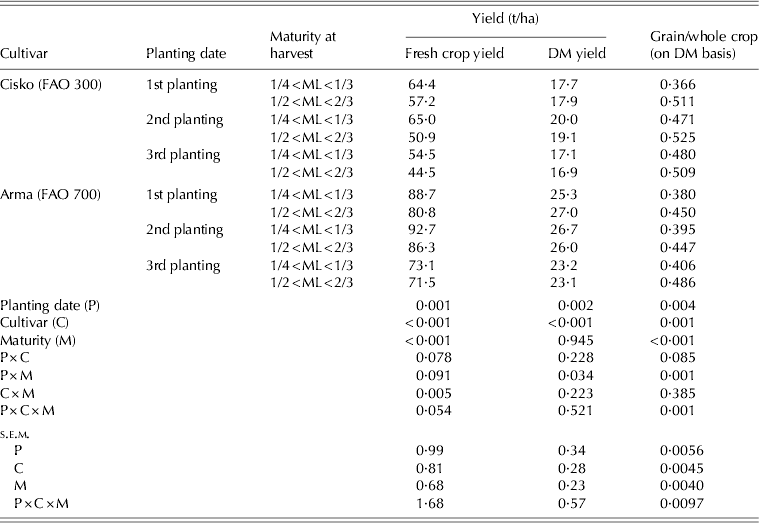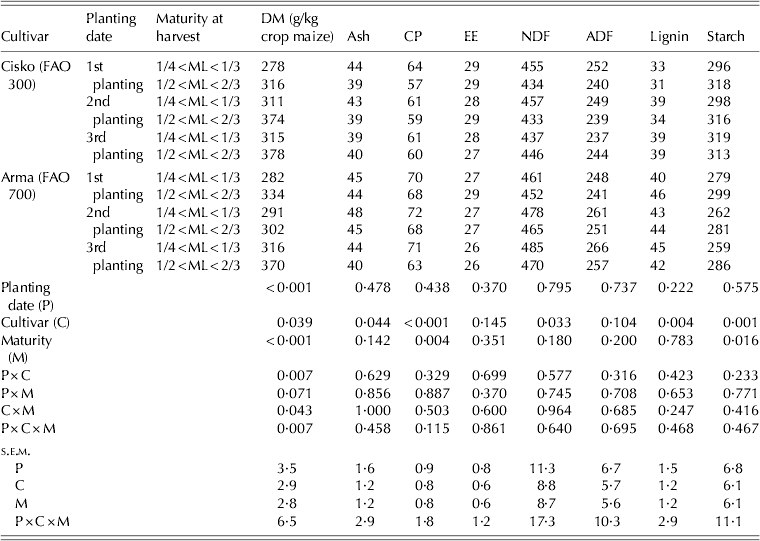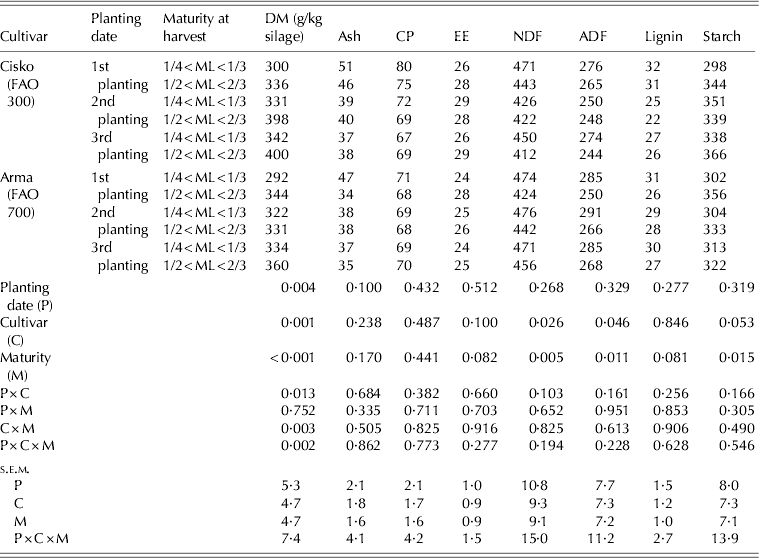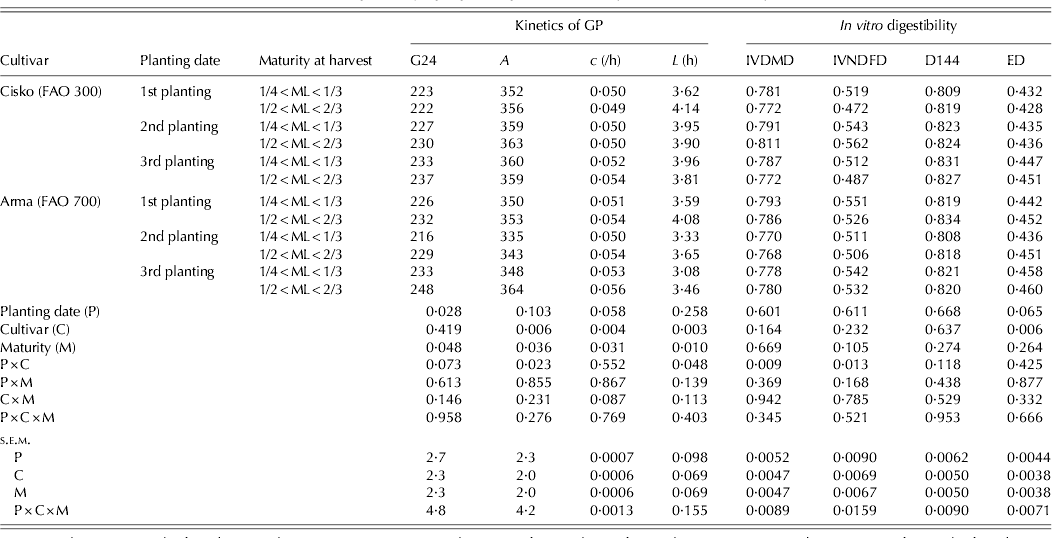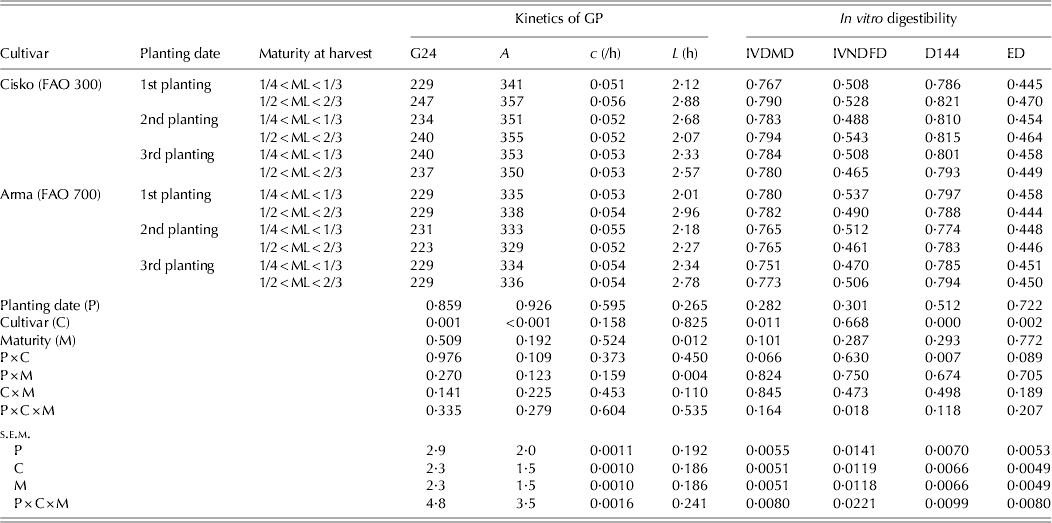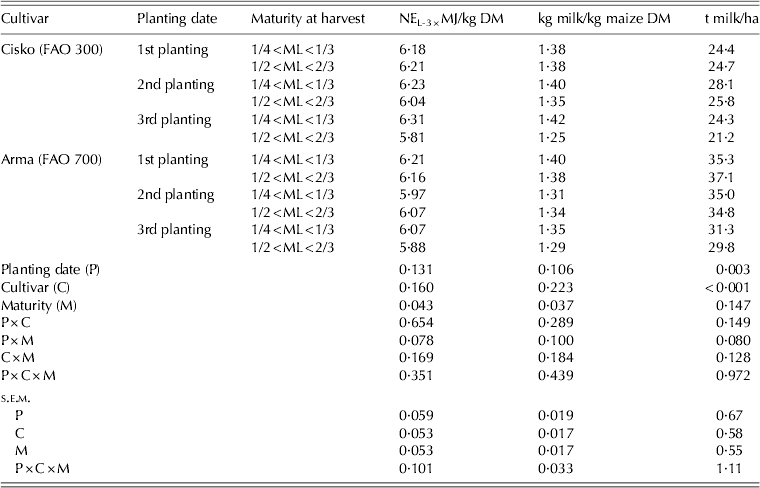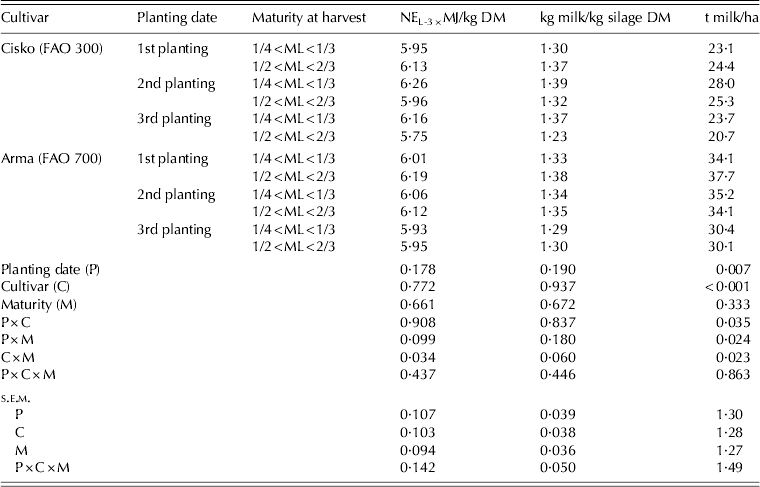INTRODUCTION
Maize (Zea mays L.) silage has high yield potential and suitable ensiling properties; it is a valuable source of energy and nutrients, and incorporation into total mixed rations (TMR) is feasible. Its use is therefore widespread as a forage for dairy cows (Johnson et al. Reference Johnson, Harrison, Davidson, Robutti, Swift, Mahenna and Shinners2002a). Factors such as total dry matter (DM) produced and amount of grain obtained were initially considered as main target indicators for selecting a maize hybrid (Cox et al. Reference Cox, Cherney, Perdee and Cherney1994). In recent years, other attributes related to nutritional quality of the feedstuff and subsequent livestock performance (e.g. high fibre and starch digestibility) have gained increasing interest, in an attempt to maximize the amount of milk produced/ha or /kg of silage (Barriere et al. Reference Barriere, Emile, Traineau and Hebert1995; Neylon & Kung Reference Neylon and Kung2003). One of the factors affecting the nutritive value and digestibility of silage is the stage of maturity at harvest (Johnson et al. Reference Johnson, Harrison, Hunt, Shinners, Doggett and Sapienza1999), which is in turn affected by management practices such as harvest date or hybrid selection (Xu et al. Reference Xu, Harrison, Kezar, Entrikin, Loney and Riley1995). Harvesting too early can be unfavourable, not only due to effluent losses of nutrients from the silo, but also because the energy content of the feed is lower due to incomplete starch accumulation in kernels (Wiersma et al. Reference Wiersma, Carter, Albrecht and Coors1993). In contrast, late harvesting at the black layer (BL) stage may result in reduced starch and fibre digestibility (Wiersma et al. Reference Wiersma, Carter, Albrecht and Coors1993). Bal et al. (Reference Bal, Coors and Shaver1997) and Johnson et al. (Reference Johnson, Harrison, Davidson, Robutti, Swift, Mahenna and Shinners2002a) have suggested that 2/3 milk line (ML) is the optimum maturity stage to harvest maize for silage to be fed to lactating dairy cows. In their review, Johnson et al. (Reference Johnson, Harrison, Hunt, Shinners, Doggett and Sapienza1999) highlighted the negative interaction between grain development and stover lignin content associated with maturity of maize. The decline in digestibility of the stover with progressive maturity is associated with decreasing non-structural carbohydrates and increasing fibre and lignin concentrations (Bal et al. Reference Bal, Coors and Shaver1997). Neutral detergent fibre (NDF) in whole crop maize decreases as maturity advances from early ML (1/3 ML) to 2/3 ML, then remains constant until the BL stage of maturity (Bal et al. Reference Bal, Coors and Shaver1997). The in situ degradability of whole crop maize decreases progressively from early to late maturity stages despite the decline in NDF content (Johnson et al. Reference Johnson, Harrison, Hunt, Shinners, Doggett and Sapienza1999). Xu et al. (Reference Xu, Harrison, Kezar, Entrikin, Loney and Riley1995) suggested a strategy to improve maize silage quality through the selection of maize hybrids that maintained stover quality with advancing maturity. High levels of dietary fibre can limit intake through ruminoreticular fill (Cox et al. Reference Cox, Cherney, Perdee and Cherney1994), thus affecting performance adversely. When rumen fill becomes a limiting factor, one approach for increasing dry matter intake (DMI) is to increase NDF digestibility. Oba & Allen (Reference Oba and Allen1999) reported that a one-unit increase in forage NDF digestibility was associated with a 0·17 kg increase in DMI and a 0·25 kg increase in 4% fat-corrected milk yield.
Laboratory methods have been developed and refined to provide information on forage quality and to obtain accurate predictions of DMI and digestibility (Damiran et al. Reference Damiran, DelCurto, Bohnert and Findholdt2008). The Ankom filter bag technique for determining in vitro digestibility allows a large number of samples to be analysed in a short time and reliable estimates of digestibility to be obtained (Damiran et al. Reference Damiran, DelCurto, Bohnert and Findholdt2008). Undersander et al. (Reference Undersander, Howard and Shaver1993) proposed an index of forage quality based on acid detergent fibre (ADF) and NDF analyses to predict the milk yield/kg of forage DM. This index was modified for maize silage by Schwab & Shaver (Reference Schwab and Shaver2001) using modified National Research Council energy values (NRC 2001), improving predictions of DMI and NDF digestibility. An updated version of this index, Milk2006 (Shaver et al. Reference Shaver, Lauer, Coors and Hoffman2006), has become a key tool for maize hybrid breeding programmes based on predictions of milk produced/kg of maize silage. In addition to in vitro digestibility, rumen fermentation kinetics assessed with the gas production (GP) technique can be used to estimate rate and extent of feed degradation in the rumen (Mauricio et al. Reference Mauricio, Mould, Dhanoa, Owen, Channa and Theodorou1999). This technique has been used to evaluate the effects of variety, growing site and cereal species (Opatpatanakit et al. Reference Opatpatanakit, Kellaway, Lean, Annison and Kirby1994), and to compare maize grains and methods of processing (DePeters et al. Reference DePeters, Getachew, Fadel, Corona and Zinn2007). The assessment of differences within hybrids characterized by different FAO maturity class can also be of significant importance.
The aim of the current study was to compare two FAO class maize hybrid cultivars, and to examine the effects of sowing date and maturity stage at harvest, and their interactions with hybrid class, on yield, chemical composition, in vitro digestibility and rumen fermentation kinetics and estimated net energy for lactation (NEL) of maize silage and the corresponding whole-crop maize before ensiling.
MATERIALS AND METHODS
Experimental procedure
The trial was conducted at the experimental farm of the University of Turin in the western Po plain, Italy (44°50′N, 7°40′E, 232 m asl), which is characterized by sandy loam soil, with a sub-alkaline pH. The climatic patterns (1978–2008) were characterized by mean daily temperature ranging from 0·6 °C in January to 22·3 °C in July, and an average maximum July temperature of 28·8 °C. The monthly and annual average air temperatures and accumulated rainfall from January to December are reported in Table 1.
Table 1. Monthly and annual mean temperatures and accumulated precipitation for the study period and the long-term average (1978–2008)
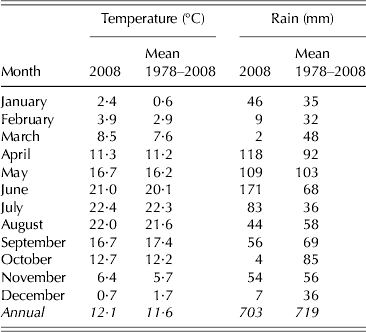
The experimental field was divided into three blocks to give three replications per treatment (one in each block). Each block was split into three (90 × 12 m) plots, which were then assigned randomly to one of three sowing dates. Within each plot, maize variety was assigned as the sub-plot factor and the harvest date was assigned as the sub-sub-plot factor within each sub-plot. Maize hybrid cultivars (Cisko and Arma, NK Syngenta Seeds S.p.A., Madignano (CR), Italy) were sown on 13 March, 9 April and 14 May 2008 at an intended planting density of 74 000 seeds/ha. Cisko and Arma are dual purpose hybrid cultivars with floury starch that can be harvested either for grain or for silage (usually high grain and forage yields). Both are included in the European catalogue of varieties of agricultural plant species (European Commission 2011) as simple hybrids and maturity ratings FAO 300 (Cisko hybrid) and FAO 700 (Arma hybrid). The FAO rating is the maize relative maturity system adopted in Europe, calculated on the basis of the number of days required for grain to contain <0·20 g moisture/g grain and developed to aid breeders and growers to place genotypes into the correct adaptation zones (Troyer Reference Troyer and Hallauer2000). The two FAO classes (FAO 300 and FAO 700 for early and late maturing maize, respectively) were chosen to represent the minimum and maximum maturity ratings of maize hybrids used for silage in the Po plain (Italy). Fertilizer was applied at the rate of 40 kg P2O5/ha and 55 kg K2O/ha immediately before planting. An additional 160 kg N/ha as urea was top-dressed at the six leaves stage. Irrigation was provided by a sprinkler system on 17 July, at a rate of 500 m3 water/ha. Thirty whole plants per plot (randomly sampled) were harvested and ensiled at two different stages of maturity, the first with ML between 1/4 and 1/3 ML, the second stage ranging from 1/2 to 2/3 ML for both hybrid cultivars. The forage was chopped to c. 12 mm. The kernel ML was measured on five plants randomly sampled from each plot following Afuakwa & Crookston (Reference Afuakwa and Crookston1984). The chopped forage from each plot was sampled for chemical analysis and ensiled in 30-litre plastic containers equipped with a lid that allowed gas release. The silos were maintained at 20 °C and opened after 240 d. Upon opening the silos, weight of silage was recorded, a layer of c. 100 mm from the top of each silo was discarded, and the remaining silage sampled for analysis. At each sampling time, 10 additional plants were randomly harvested and separated by hand into grain, stalk, leaves, tassel, husk and cob. Each plant part was dried separately and the ratio between grain and whole plant was calculated on a DM basis.
Sample preparation and chemical analysis
Samples were assayed in duplicate according to AOAC (2000). The pre-ensiled whole-crop maize and the silage were oven-dried at 60 °C for 72 h, weighed to determine DM content and ground in a Cyclotec mill (Tecator, Herndon, VA, USA) to pass through a 1 mm screen. Samples were analysed for crude protein (CP), ash, ether extract (EE) and starch concentration according to the AOAC methods 954·01, 942·05, 920·39 and 920·40, respectively (AOAC 2000). The NDF, ADF and lignin were determined using an Ankom fibre analyser (Ankom Technology Corp., Fairport, NY, USA), following the procedure of Van Soest et al. (Reference Van Soest, Robertson and Lewis1991). The NDF was analysed with the addition of sodium sulphite and heat stable amylase to the solution. Silage sample preparation and analyses were performed as described in detail by Tabacco et al. (Reference Tabacco, Righi, Quarantelli and Borreani2011). The silage pH was determined in a water extract, using a pH meter (Mettler Toledo, Novate Milanese, Italy) with a glass electrode. The water extract was obtained by mixing 30 g of silage with 270 ml of distilled water in a Stomacher blender (Seward Ltd, UK) for 4 min. The lactic and short-chain fatty acids (acetic, propionic and butyric acids) were determined by high performance liquid chromatography (HPLC; Agilent Technologies Italia, Cernusco sul Naviglio, Italy) in an aqueous acid extract obtained after blending (for 4 min) 50 g of fresh silage mixed with 250 ml of H2SO4 0·05 m.
Animals and rumen fluid collection
Six rumen-fistulated Merino sheep were used as donors of ruminal inoculum for the in vitro assays. Animals were fed good-quality alfalfa hay and had free access to clean water. A sample of ruminal contents was collected before the morning feeding in thermos flasks and taken to the laboratory where it was strained through two layers of cheesecloth, kept at 39 °C under CO2 atmosphere and diluted (1:4, v/v) with a culture medium containing macro and micro mineral solutions, resazurin and a bicarbonate buffer solution, prepared as described by Menke & Steingass (Reference Menke and Steingass1988). Oxygen was reduced by the addition of a solution containing cysteine hydrochloride and Na2S.
Animal handling followed the recommendations of European Council Directive 86/609/EEC for protection of animals used for experimental and other scientific purposes, and experimental procedures were approved by the University of León (Spain) Institutional Animal Care and Use Committee.
In vitro GP
In vitro GP measurements were conducted using a pressure transducer (Delta Ohm, Caselle di Selvazzano, Italy) as described by Theodorou et al. (Reference Theodorou, Williams, Dhanoa, McAllan and France1994), in which 0·50 ± 0·01 g of sample was incubated in a 120 ml serum bottle containing 50 ml of diluted rumen fluid. Blanks were used to compensate for GP in the absence of added substrate. Once filled, bottles were sealed with rubber stoppers and aluminium seals, shaken and placed in the incubator (Shel Lab, Sheldon Manufacturing, Inc., Cornelius, OR, USA) at 39 °C. The head-space gas pressure released upon fermentation of feed was measured manually by inserting a sterile needle connected to the pressure transducer after incubation for 3, 6, 9, 12, 16, 21, 26, 31, 36, 48, 60, 72, 96, 120 and 144 h. Gas volume was estimated from pressure measurements using the equation proposed by López et al. (Reference López, Dhanoa, Dijkstra, Bannink, Kebreab and France2007). Two incubation runs were performed in different weeks, using two bottles per sample and three bottles containing only medium as blanks in each run. The incubation residue after 144 h of fermentation was determined by filtration to estimate the potential DM disappearance (D144). In order to assess the parameters of fermentation kinetics, the exponential model proposed by France et al. (Reference France, Dijkstra, Dhanoa, Lopéz and Bannink2000) was fitted to GP profiles:
where G (ml/g DM incubated) is the cumulative GP at time t (h), A (ml/g DM) is the asymptotic GP, c (/h) is the fractional rate of fermentation and L (h) is the lag time.
Volume of gas (ml/g DM) produced after 24 h of incubation (G24) was used as an index of digestibility and energy feed value, as suggested by Menke & Steingass (Reference Menke and Steingass1988). The extent of degradation (ED) in the rumen, for a rate of passage (k) of 0·033/h (characteristic of forage at maintenance level of intake (Carro et al. Reference Carro, López, González and Ovejero1991)), was estimated using the equation suggested by France et al. (Reference France, Dijkstra, Dhanoa, Lopéz and Bannink2000):
In vitro digestibility
In vitro dry matter digestibility (IVDMD) was determined using the Ankom–Daisy procedure following the approach proposed by Van Soest et al. (Reference Van Soest, Wine and Moore1966). Samples (0·25 ± 0·01 g) were weighed into F57 Ankom bags (Ankom Technology Corp., Fairport, NY, USA) with a pore size of 25 μm, heat-sealed and then placed into an incubation vessel. Each vessel was a 5-litre glass container with a plastic lid provided with a single-way valve, which prevents the accumulation of fermentation gases, and was filled with 2 litres of buffered rumen fluid in anaerobic conditions, then placed into the DaisyII Incubator (Ankom Technology Corp., Fairport, NY, USA). Temperature was maintained at 39 °C in the incubator with continuous rotation. After 48 h of incubation the vessels were emptied and the bags were gently rinsed under tap water and dried in an oven at 60 °C. Bags were then washed with a neutral detergent solution at 100 °C for 1 h and rinsed with distilled water into the fibre analyser, so as to remove bacterial debris. In vitro NDF degradation (IVNDFD) was estimated from the amount of NDF incubated. Each sample was replicated in four incubation runs carried out in different weeks.
Statistical analysis
The model Milk2006 (Shaver et al. Reference Shaver, Lauer, Coors and Hoffman2006) was used to estimate energy values (NEL, NRC 2001) of maize fodder and silage, and to make predictions of probable milk yield/kg DM of each forage and per ha based on its chemical composition and digestibility. Milk2006 uses updated information and user-defined input flexibility for these predictions.
Chemical composition, GP parameters, in vitro digestibility, estimated energy value and milk production data of pre-ensiled whole-crop maize and of silage were analysed by ANOVA according to a split–split–plot design with the whole plots arranged in a randomized complete-block design, and involving three experimental factors (fixed effects), namely planting date, maize cultivar and harvest date. Planting date was the whole-plot factor, maize cultivar the sub-plot factor (within each whole plot), and harvest date the sub-sub-plot factor (within each sub-plot). Random effects were: planting date × block as the whole-plot error to test planting date effects, planting date × cultivar × block as the sub-plot error to test variety effects and cultivar × planting date interaction, and the pooled residual error to test maturity effects and its interactions with planting date and cultivar effects. Analyses were carried out using the PROC MIXED procedure of SAS (SAS Institute 2004). Mean values of each parameter and s.e.m. are reported in the Tables.
RESULTS
Whole crop maize production
Whole-crop maize yield (fresh crop and DM) and grain:whole crop ratio are presented in Table 2. Whole crop yield (fresh or DM) was 40% greater (P < 0·001) with Arma (82·2 t whole-crop and 25·2 t DM/ha) than with Cisko (56·1 t whole-crop and 18·1 t DM/ha). There was a slight increase in DM yield from the first to the second planting date for the Cisko hybrid, and a decrease on the third sowing date for both hybrids. Harvest maturity of maize had an impact (P < 0·001) on fresh silage yield/ha, decreasing as maturity advanced for both hybrids (73·1 and 65·2 t whole-crop maize/ha for early and late harvest, respectively), but DM yield was not affected by maturity.
Table 2. Yield and grain to crop ratio of whole crop maize

Cultivar, sowing date and harvesting maturity affected (P < 0·01) grain:whole crop ratio. Cisko (0·48) showed a higher grain proportion than Arma (0·43), with larger differences between hybrids for the second and third planting dates. The contribution of the grain to the whole crop maize yield increased from 1/4 < ML < 1/3 (0·42) to 1/2 < ML < 2/3 (0·49), with greater differences between maturity stages for the Cisko hybrid in the first planting date.
Chemical composition
The chemical composition of pre-ensiled whole-crop maize is presented in Table 3. The DM content for both cultivars increased (P < 0·001) with later maturity stage. The ash content was similar across cultivars, planting and harvest dates. The CP, NDF, lignin and starch concentrations of the pre-ensiled whole-crop maize were affected by cultivar (P < 0·05), with Arma having higher values of CP (68·7 v. 60·3 g/kg DM), NDF (468 v. 444 g/kg DM) and lignin (43·3 v. 35·9 g/kg DM), and lower values of starch (278 v. 310 g/kg DM) than the Cisko hybrid. Maturity had an effect (P < 0·05) on CP and starch concentrations of the pre-ensiled whole-crop maize, with decreasing CP (66·5 v. 62·6 g/kg DM) and increased starch (285 v. 302 g/kg DM) contents for early (1/4 < ML < 2/3) compared with mid-late (1/2 < ML < 2/3) maturity. The chemical composition of maize silage is presented in Table 4. All the silages had undergone an apparently good fermentation with pH values ranging from 3·58 to 4·02 and negligible butyric acid concentrations detected in all the experimental silos (data not shown). Maize silage obtained from Arma had a higher (P < 0·05) NDF content than that from Cisko (457 v. 437 g/kg DM, respectively). The NDF (460 v. 433 g/kg DM) and ADF (275 v. 257 g/kg DM) content declined (P < 0·05), whereas starch (318 v. 343 g/kg DM) content increased (P < 0·05), from the early (1/4 < ML < 1/3) to mid-late (1/2 < ML< 2/3) maturity. In general, maize silages showed a similar chemical composition to the corresponding pre-ensiled whole-crop maize, although DM and starch were in many cases slightly greater in the silage.
Table 3. Chemical composition of pre-ensiled whole-crop maize (g/kg DM, except DM)

Table 4. Chemical composition of maize silage (g/kg DM, except DM)

In vitro digestibility and parameters of GP kinetics
Treatment (cultivar and planting date) and interaction effects on GP kinetics and in vitro digestibility for pre-ensiled whole-crop maize and for silage are presented in Tables 5 and 6, respectively.
Table 5. Rumen fermentation kinetics and in vitro digestibility (g digested/g incubated) of pre-ensiled whole-crop maize

G24, cumulative GP at 24 h of incubation (ml/g DM); A, asymptotic GP (ml/g DM); c, fractional rate of GP; L, lag time; D144, DM disappearance after 144 h of incubation.
Table 6. Rumen fermentation kinetics and in vitro digestibility (g digested /g incubated) of maize silage

G24, cumulative GP at 24 h of incubation (ml/g DM); A, asymptotic GP (ml/g DM); c, fractional rate of GP; L, lag time; D144, DM disappearance after 144 h of incubation.
In pre-ensiled whole-crop maize, all GP parameters were significantly increased (P < 0·05) with maturity at harvest. Cisko maize showed on average greater asymptotic GP (358 v. 349 ml/g DM), slower GP rates (0·051 v. 0·053/h) and longer lag times (3·9 v. 3·5 h) than Arma (P < 0·01). As a result, effective degradability estimated from these parameters was greater (P < 0·01) for Arma (0·450) than for Cisko (0·438) maize. Planting date only affected G24 values (P < 0·05), which tended to increase as planting date was delayed. Estimated IVDMD and IVNDFD at 48 h of incubation showed an average value of 0·782 g/g DM and 0·522 g/g DM, respectively, and were not affected by any of the treatments, with only a significant (P < 0·05) cultivar × planting date interaction.
Treatment effects were less consistent in silages. There was a significant effect of cultivar on G24 (238 v. 229 ml/g DM) and A (351 v. 334 ml/g DM) parameters and on IVDMD (0·783 v. 0·769) and effective degradability (0·457 v. 0·450), which were greater (P < 0·05) in Cisko than in Arma silage.
Estimated energy value and milk production
Estimated net energy content and predicted potential milk yield from pre-ensiled whole-crop maize and from silage are reported in Tables 7 and 8, respectively. Cultivar affected (P < 0·001) milk yield/ha (t/ha) of pre-ensiled whole-crop maize, with Arma showing a 38% higher value than Cisko. The NEL and the potential milk production (kg/kg forage DM) were similar for the two hybrids and across planting dates, and they were slightly greater (P < 0·05) for the earlier maturity stage. The sowing date affected (P < 0·01) the milk production/ha, with greater values at the first two planting dates.
Table 7. Estimated energy value and milk production of pre-ensiled whole-crop maize (Milk 2006 model)

Table 8. Estimated energy value and milk production of maize silage (Milk 2006 model)

The potential milk yield/ha of the maize silage was affected (P < 0·01) both by cultivar and sowing date, with greater values for Arma than for Cisko (33·4 v. 24·3 t milk/ha) and lower values for the third planting date, whereas the NEL and the potential milk production (kg/kg silage DM) were not affected (P > 0·05) by any of the treatments.
DISCUSSION
Chemical composition
Changing management practices can be a strategy to influence the nutritive value of maize silage. The proper selection of the hybrid used for producing whole-crop silage is a key issue to obtain high forage yield and favourable nutritional characteristics. The hybrid should be of the proper maturity rating for the area in which it is grown in order to maximize the full growing season available in terms of growing degree days. In the environmental conditions of the experimental site for the current study, the late maturing hybrid (Arma FAO 700) showed the potential of producing >23 t DM/ha, up to 38% more than the early maturity hybrid (Cisko FAO 300). DM yields of whole-crop maize were within the expected range for maize hybrids grown in the Mediterranean area (Tabacco et al. Reference Tabacco, Righi, Quarantelli and Borreani2011), with similar observed differences between early (FAO 300) and late (FAO 700) maturity classes (Masoero et al. Reference Masoero, Gallo, Zanfi, Giuberti and Spanghero2011; Randjelovic et al. Reference Randjelovic, Prodanovic, Tomic, Bijelic and Simic2011). Ensiling at the correct DM concentration and optimum stage of maturity is also critical to achieving good quality composition of the resulting silage.
In the current study, advancing the stage of maturity of whole-plant maize at harvest from 1/4 < ML < 1/3 to 1/2 < ML < 2/3 increased the DM concentration for both cultivars, in agreement with other reported results (Hunt et al. Reference Hunt, Kezar and Vinande1989; Xu et al. Reference Xu, Harrison, Kezar, Entrikin, Loney and Riley1995; Johnson et al. Reference Johnson, Harrison, Davidson, Robutti, Swift, Mahenna and Shinners2002a, Reference Johnson, Harrison, Davidson, Hunt, Mahanna and Shinners2003). This effect can be related to differences in kernel development (Argillier et al. Reference Argillier, Hebert and Barriere1995). Furthermore, maturity had an effect on fibre content, which declined with later maturity for both cultivars. Similar trends have been reported by Hunt et al. (Reference Hunt, Kezar and Vinande1989) and Johnson et al. (Reference Johnson, Harrison, Davidson, Robutti, Swift, Mahenna and Shinners2002a) who observed a decrease in NDF and ADF concentrations in maize silage from 1/3 ML to 2/3 ML maturity stages. This decrease was related to a higher proportion of grain in mature whole-plant maize, and the results are consistent with those of Argillier et al. (Reference Argillier, Hebert and Barriere1995) who stated that although the fibre content of the stover increases with maturity, the fibre content of whole-plant maize decreases due to an increasing proportion of grain. In the present experiment the changes in the starch content with grain maturity showed an opposite trend to that observed for fibre. The increase in starch should be attributed to the greater proportion of grain in the more mature whole-plant maize, in agreement with other authors (Bal et al. Reference Bal, Coors and Shaver1997; Johnson et al. Reference Johnson, Harrison, Davidson, Robutti, Swift, Mahenna and Shinners2002a).
In vitro digestibility and parameters of GP kinetics
Digestibility of maize silage was determined by the conventional in vitro technique with Ankom procedure following the approach proposed by Van Soest et al. (Reference Van Soest, Wine and Moore1966). Rate and extent of ruminal degradation were estimated from GP profiles derived from in vitro incubation of maize fodder and silage samples in buffered rumen fluid (Theodorou et al. Reference Theodorou, Williams, Dhanoa, McAllan and France1994). This method has been accepted as a sensitive and reliable tool in feed evaluation (López Reference López, Dijkstra, Forbes and France2005), because GP correlates well with in vivo and in vitro digestibility (Khazaal et al. Reference Khazaal, Markantonatos, Nastis and Ørskov1993; López Reference López, Dijkstra, Forbes and France2005) and with microbial protein synthesis (Blümmel et al. Reference Blümmel, Steingass and Becker1997). This technique has already been used by DePeters et al. (Reference DePeters, Getachew, Fadel, Corona and Zinn2007) to compare maize hybrids and processing methods.
In the present study, the IVDMD and IVNDFD of pre-ensiled whole-crop maize were not affected by cultivar, planting date and maturity. In contrast, other authors (Johnson et al. Reference Johnson, Harrison, Davidson, Swift, Mahanna and Shinners2002b, Reference Johnson, Harrison, Davidson, Hunt, Mahanna and Shinners2003; Lewis et al. Reference Lewis, Cox and Cherney2004) found that DM and NDF digestibility were lower at later maturity stages. An explanation for this discrepancy would be the later stage of maturity of the maize used by the above authors, with a greater ML than the mature stage used in the current study (1/2–2/3 ML). Different response of cultivars to sowing date may be related to the differences in the climatic conditions influencing the growth and development of each hybrid, such as temperature and growing degree days during the spring months. In silage, observed differences in DM digestibility can be partially explained by the different NDF and lignin contents in maize of each hybrid. According to Bal et al. (Reference Bal, Shaver, Shinners, Coors, Lauer, Straub and Koegel2000) and Johnson et al. (Reference Johnson, Harrison, Davidson, Hunt, Mahanna and Shinners2003) the DM digestibility in maize silage is greater as NDF is lower, as a result of the increased content of digestible starch. Differences in digestibility are primarily associated with the chemical composition of the silage, especially to their cell wall and lignin content (Ivan et al. Reference Ivan, Grant, Weakley and Beck2005). The cell wall fraction may have a negative influence on digestibility as described in conventional feedstuffs by Van Soest (Reference Van Soest1994). Cell contents (starch) are readily and completely digested, whereas cell walls are slowly digested and only to a certain extent, depending on their degree of lignification.
In general, cultivar, sowing date and maturity effects on rumen fermentation kinetics followed a trend similar to that observed for chemical composition and in vitro digestibility of maize and silage. Hetta et al. (Reference Hetta, Mussadiq, Gustavsson and Swensson2012) used the GP technique to assess the digestibility and rate of degradation in the rumen of maize silage and concluded that the technique was valuable to evaluate hybrid and maturity effects on the nutritional value of maize silage.
The apparent differences between the pre-ensiled whole-crop and the maize silage were of little biological significance, and could be attributed to the fermentation of water-soluble carbohydrates contained in the pre-ensiled material.
Estimated energy value and milk production
Yield and nutrient analysis data of maize silage were used as inputs for Milk2006 (Shaver et al. Reference Shaver, Lauer, Coors and Hoffman2006) to estimate the net energy for lactation at 3 × maintenance (NEL − 3×), milk production/kg DM and per ha (t milk/ha). In vitro NDF digestibility at 48 h of incubation was used as the cell wall digestibility value required by the model for the calculations. Expected silage energy value and animal responses to feeding of maize silage calculated from Milk2006 were within the range reported by other authors using the same model (Schwab et al. Reference Schwab, Shaver, Lauer and Coors2003; Tabacco et al. Reference Tabacco, Righi, Quarantelli and Borreani2011). Given the lack of cultivar, sowing date and maturity effects on NDF digestibility, no differences in energy value or expected milk production from maize silage were expected. This finding is in agreement with Oba & Allen (Reference Oba and Allen1999), who concluded that the expected animal responses to feeding of maize silage depend mainly on the digestibility of the cell wall. Likewise, Johnson et al. (Reference Johnson, Harrison, Hunt, Shinners, Doggett and Sapienza1999) observed that maize maturity had a limited effect on animal performance in dairy cows fed maize silage of increasing maturity.
The 38% higher milk yield/ha observed for Arma is in agreement with the fodder yield, since this hybrid produced c. 40% more t milk/ha than Cisko. Regarding other variables, there were no differences between cultivars or maturity stage in energy value and potential milk yield/kg DM. Reduced values of milk production/ha for the latest planting date mainly reflected the differences observed in DM yield.
In the present experiment, when maize was harvested at 1/4 < ML < 1/3, NEL values (6·1 v. 6·0 MJ/kg DM) and milk production (1·34 v. 1·32 kg/kg silage DM) were greater than those predicted for maize harvested at 1/2 < ML < 2/3. However, these differences seem to be of little biological significance, and no differences were observed for the potential milk yield/ha (t/ha). In silage, cultivar and planting date affected milk production/ha (t/ha), with greater values for Arma than for Cisko and reduced values for the latest planting date, as observed in pre-ensiled whole-crop maize.
CONCLUSIONS
The late maturing maize hybrid (Arma FAO 700) yields more fodder and silage than the early maturing maize hybrid (Cisko FAO 300), with no differences between cultivars in the chemical composition and in vitro digestibility of maize and silage. Estimated energy and expected milk production calculated with Milk2006 emphasized that milk yield/ha will be greater with Arma than with Cisko maize silage due to the differences in DM yield/ha. The stage of maturity has a limited effect on the nutritional value of maize silage, with no substantial change in silage feeding value within a range in maturity between 1/4 and 2/3 ML.
The authors would like to thank Ana Belén Rodríguez Gutiérrez and Raúl Bodas (Instituto de Ganadería de Montaña, CSIC – Universidad de León, Spain), Roberta Alves Gomes (Universidade Federal da Grande Dourados, UFGD, Brazil), and Andrea Revello Chion (Dipartimento di Agronomia, Selvicoltura e Gestione del Territorio, Università degli Studi di Torino, Italy) for their contribution to field and laboratory analyses. This work was funded by the Regione Piemonte, Assessorato Qualità, Ambiente e Agricoltura (Project Rep. no. 13428), the Ministero dell'Università e della Ricerca, PRIN (Project 2007P8JMWJ_002) and Junta de Castilla y León, Spain (Project GR158). All the authors contributed equally to the work described in this paper. Mention of trade names is for the benefit of the reader and does not constitute endorsement by the University of Turin, Italy and of Leon, Spain, over other products not mentioned.





